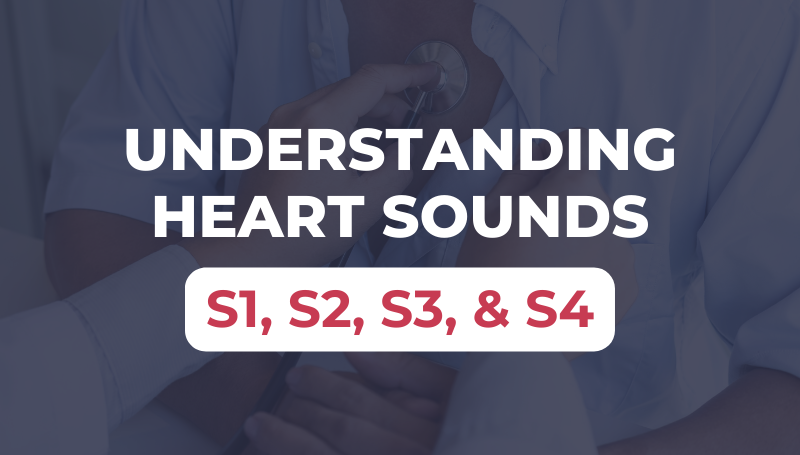Everything Med Students Need to Know About S1, S2, S3, & S4 Heart Sounds

Key takeaways:
- Systolic heart sounds include the 1st heart sound (S1) and clicks. Diastolic heart sounds include the 2nd, 3rd, and 4th heart sounds (S2, S3, and S4), as well as knocks and snaps.
- S1 is a high-pitched sound caused by the closing of the mitral and tricuspid valves just after the beginning of systole.
- S2 is a low-pitched sound caused by the closing of the aortic (A2) and pulmonic (P2) valves at the beginning of diastole.
- S3 is an abnormal heart sound in adults. When present, it occurs in early diastole, immediately after S2. It indicates the end of rapid ventricular filling.
- S4 is an abnormal heart sound. When present, it occurs just before S1 at the end of diastole.
We're sharing these excerpts from our Medical Student Core Cardiology book to review the most important things you need to do when listening to heart sounds during a cardiovascular exam.
According to this competency in cardiac examination skills study, your cardiac exam skills don't improve after your third year of med school and may actually decline after years in clinical practice. Whether you're a seasoned practitioner or a medical student, focusing on your auscultation skills this month will not only reinforce your expertise but also illuminate the critical role of cardiac auscultation in diagnosing and managing patient conditions. Let's review S1, S2, S3, S4, and other heart sounds:
Overview: S1, S2, S3, and S4 heart sounds
Listen to Heart Sounds S1, S2, S3, & S4
Heart sounds are brief sounds produced by the opening and closing of valves. Systolic heart sounds include the 1st heart sound (S1) and clicks. Diastolic heart sounds include the 2nd, 3rd, and 4th heart sounds (S2, S3, and S4), as well as knocks and snaps. Let's take a closer look at each:
What are S1 and S2 heart sounds?
Heart sounds — S1
S1 is a high-pitched sound caused by the closing of the mitral and tricuspid valves just after the beginning of systole. Mitral valve closure occurs first and is the louder component of S1. Several conditions affect the intensity, or loudness, of S1:
- S1 is soft or absent in conditions that cause the mitral valve to begin closing earlier than normal, prior to the onset of systole. Examples of this situation include MR, acute aortic regurgitation (AR; increased LV pressure causes early mitral valve closure), or a severely calcified mitral valve.
- S1 is loud (i.e., the mitral valve slams shut) when there is a short PR interval, MS, or hyperdynamic ventricular function.
Heart sounds — S2
S2 is a low-pitched sound caused by the closing of the aortic (A2) and pulmonic (P2) valves at the beginning of diastole. A2 usually occurs just before P2. This physiologic split is larger during inspiration because the increased volume of blood in the RV prolongs RV systole and delays closure of the pulmonic valve. There are several abnormal forms of S2 splitting:
- A widely split S2 varies with respiration, but the splitting does not disappear on expiration. This often is due to a delay in closure of the P2, as in severe pulmonic stenosis (PS), acute pulmonary embolism (PE), or complete right bundle-branch block (RBBB). These conditions cause delayed or prolonged contraction of the RV. Early closure of the aortic valve (A2) also causes widely split S2, as in MR.
- A fixed split S2 does not vary with respiration. This finding occurs with an atrial septal defect (ASD), due to the increased RV flow. There is no variation in aortic and pulmonary valve closure that normally occurs with respiration. RV failure is another cause of a fixed split S2.
- A paradoxically split S2 is due to delay of aortic valve closure (A2), with P2 occurring before A2. In this case, the split is larger during expiration instead of during inspiration. This is commonly caused by left bundle-brand block (LBBB), or with severe LV outflow tract obstruction such as in AS or severe HCM.
What are S3 and S4 heart sounds?
Heart sounds — S3
S3 is an abnormal heart sound in adults. When present, it occurs in early diastole, immediately after S2. It indicates the end of rapid ventricular filling.
On auscultation, it creates a pattern that sounds like "Ken-tuck-y," corresponding to S1, S2, then S3. This often is referred to as a "gallop," a term coined in 1847 to describe the cadence of 3 heart sounds occurring in rapid succession.
The sound is thought to be due to the tensing of the chordae tendinae. S3 often is a normal finding in pregnant women and young children. However, in adults, it usually indicated severe LV systolic dysfunction, especially conditions that increase early LV filling, such as acute ventricular failure or severe aortic or mitral regurgitation. An S3 in a patient with LV dysfunction is a poor prognostic indicator.
Note that S3 is best heard during expiration (so that the heart will be closer to the chest wall), using the bell of the stethoscope with the patient in the left lateral decubitus position (i.e., the patient is lying on his left side).
Heart sounds — S4
S4 is an abnormal heart sound. When present, it occurs just before S1 at the end of diastole. On auscultation, it sounds like "Tenn-e-ssee," corresponding to S4, S1, and S2, also referred to as a "gallop." S4 is caused by increased ventricular filling during atrial contraction, occurring in patients with decreased ventricular compliance.
You may hear an S4 in ischemic heart disease, AS, HCM, diabetic cardiomyopathy, and hypertensive heart disease with concentric hypertrophy. Note that S4 sometimes occurs with S3 in patients with LV systolic dysfunction but that S4 alone indicates LV diastolic dysfunction.
Note that like S3, S4 is best heard using the bell of the stethoscope with the patient in the left lateral decubitus position.
Other heart sounds
What is a heart click?
Clicks occur only during systole and are single or multiple. They are briefer and have a higher pitch than S1 or S2. In MVP, a click occurs in mid to late systole and is thought to be due to abnormal tension on the valve leaflets or chordae tendinae.
What is a diastolic knock?
A diastolic knock is a loud, high-pitched, thudding sound that occurs at the same time as S3. It indicates the sudden cessation of rapid ventricular filling due to the presence of a noncompliant pericardium, as in constrictive pericarditis.
What is an opening snap?
An opening snap is a brief, high-pitched sound heard best with the diaphragm of the stethoscope at the left lower sternal border (LLSB).
Start refining your auscultation skills for American Heart Month! Check out MedStudy Heart Sounds to practice recognizing the most important (and the rarest) heart sounds.


